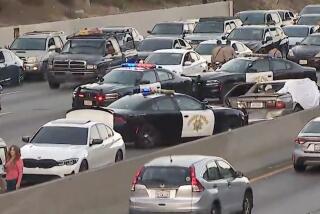Shutdown Has Commuters Snarling
- Share via
After a construction accident left power lines dangling precariously over the San Diego Freeway at 4 a.m. Thursday, it would be five hours--and well after the harried morning rush-hour commute--before one of the nation’s busiest roadways was reopened to traffic.
Officials said they acted as fast as they could, but that was small comfort to some motorists who found themselves either caught in a parking lot on the freeway or weaving through jammed surface streets.
“I was so mad,” said Tiffany Davis, a receptionist whose normal 30-minute commute from Santa Monica to Torrance lasted an hour and a half. “I could look in my rear-view mirror and see people behind me yelling and screaming.”
Davis got off the freeway near Los Angeles International Airport, only to meet a similar mess on side streets as motorists fled the tie-up on the San Diego Freeway at Western Avenue. “Every street I took, there were people.”
The accident provided a glimpse into the anatomy of a SigAlert, an event that occurs just about every day--or sometimes several times a day--in the Los Angeles region.
An accident can be designated as a SigAlert by the CHP officer on the scene whenever one or more freeway lanes will be blocked for more than half an hour. As a result of Thursday’s mishap, lanes in both directions were closed for more than five hours.
SigAlert warnings are put out by the California Highway Patrol and are most often heard over the radio as motorists drive to and from work.
The dreaded expression is named after Loyd Sigmon, a radio station executive for KMPC who developed a traffic advisory system in 1955.
Thursday’s problems began when a crane for a private contractor working on a sound wall inadvertently snagged a power line and pulled it hard enough to snap the wooden pole. It was left hanging by the wires over Western Avenue next to the freeway.
“It was like a fishing pole,” said Ron Griffin, superintendent of the electrical repair crews for the DWP. But instead of the line breaking, “it was the fishing pole that broke.”
At 4:09 a.m., the CHP received a call about the accident and sent officers to view the scene and close the freeway.
It took until 9:29 a.m. for the SigAlert to be canceled.
Why did it take nearly five hours to reopen the freeway?
Officials with Caltrans and the DWP say they worked as fast as they safely could.
The response was somewhat delayed when authorities, working in darkness, mistakenly called Southern California Edison Co. at 4:26. They soon learned that the power lines belonged to the DWP, whose crews arrived about 5 a.m.
A DWP spokesman said the utility received its first call at 4:44 and had a crew on the scene within 15 minutes.
“The major problem was trying to get the wires untangled from the contractor’s crane,” Griffin said. The response was complicated by the fact that the shattered power pole was hanging at a 45-degree angle.
Why couldn’t the DWP simply snip the power lines dangling over the freeway and wait to make repairs until after the rush hour?
DWP officials said that if they cut the wires without securing the pole, it would have crashed down onto the street.
They had to wait for equipment. “We actually used two cranes to secure the pole while we released the wires,” Griffin said. “And that’s what took so long.”
*
Additionally, a 300-pound transformer was hanging precariously over the street, endangering crews that worked below, Griffin said.
“We had crews coming in at 7 and 7:30 which came and assisted us,” Griffin said.
Once the poles was secured, “we were able to cut the wires on both sides of the freeway.”
Making matters worse for commuters is that the Caltrans trucks that carry large message signs warning motorists of freeway closures never made it out.
The trucks were on their way out but were called back when DWP expected to complete repairs by 7:30 a.m., said a Caltrans spokesman. As it turned out, the repairs would not be completed until after 9.
Permanent freeway signs as far as Glendale warned motorists about the closure, and the warnings helped some motorists escape the freeway.
*
Across the street from the downed pole, Sue Okada, 82, waited for her customers to navigate the mess to the nursery she and her husband bought long before the freeway existed. Although Western Avenue near the freeway was still closed, loyal customers parked down the street and made the walk.
After a torturous drive from Brentwood, landscaper Onesimo Garcia parked his truck at a nearby gas station. He only came for a few trays of ornamental kale but didn’t regret making the long trip.
“I work all the way up there, but here they give me a good deal,” he said.
Okada thought it was strange that a single power pole in front of her nursery could wreak havoc across the Southland.
“People have been calling me on the phone saying, ‘Oh, your place is on the TV,” she said.
Farther up the street, David Kaveh, a car salesman at South Bay Toyota, said the stop-and-go traffic that was detoured down his street helped him sell a car. “She broke down right up the street,” he said of the impulsive customer. “She overheated in the traffic.”
More to Read
Sign up for Essential California
The most important California stories and recommendations in your inbox every morning.
You may occasionally receive promotional content from the Los Angeles Times.












